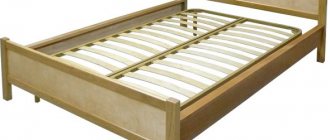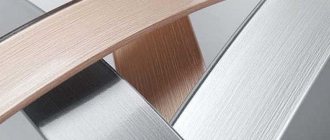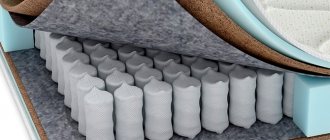A folding bed has a number of important features, thanks to which more and more people are looking at this type of furniture. Obviously, the main thing of all is tangible space savings, which is very important for small living spaces. In addition, beds can act as storage for things, thereby freeing up space in already installed cabinets.
But the long, and most importantly trouble-free use of lifting beds directly depends on their correct use. Today we will talk about important notes when using folding sunbeds.
What is a gas furniture lift?
The main elements included in the design of a furniture gas elevator are:
- the rod with which the mechanism operates;
- guide for rod movement;
- bearing facilitating sliding;
- piston;
- sleeve with gas;
- sealing gaskets that give the system complete tightness.
What does a furniture gas lift do and why is the device installed? Using the mechanism you can:
- open and close cabinet doors smoothly and silently, which eliminates the possibility of sudden contact of the facade with the furniture body and extends the life of the furniture;
- fix the doors in the open or closed position;
- gain maximum access to the contents of the cabinet and view all items stored in it.
In addition to the cabinet, gas elevators can also be installed on any other folding systems, for example, for lifting beds, disassembling/assembling sofas, sectional tables, for an office or children's chair, and so on.
Main selection criteria
To choose the right gas elevator, you will need to determine:
- type of system;
- technical specifications;
- manufacturer.
Types of gas lifts. Their advantages and disadvantages
To assemble furniture we use:
- direct action lift;
- reverse action lift.
A direct-acting gas elevator operates on compression. This is the most popular version of the lifting system, as it is simple to manufacture, lower cost and easy to install.
Direct acting gas lifts
Reverse-action furniture lifts, on the contrary, work to extend the rod. Fittings are more complex to manufacture, as high precision is required during production, which primarily affects the cost of the equipment.
Reverse action furniture lifts
Gas elevators can also vary in how they open. There are models:
- with a step-by-step design, that is, manual opening. The cabinet door or other folding element in this situation is equipped with a handle that facilitates the process of controlling the lifting mechanism;
- with automatic design. In this case, the lift is equipped with an electric drive that drives the lifting mechanism.
Electric furniture lift
Determination of technical parameters
In order for a pneumatic gas elevator to serve for a long time, you will need to determine:
- compression force;
- equipment dimensions.
When calculating independently, the compression force of the spring is determined taking into account:
- weight of the folding structure (facade, bed, rising part of the chair, etc.);
- the distance determined from the center of the axis of operation of the equipment to the middle of the lever (center of gravity);
- height between the center of the system axis and the equipment mounting location;
- number of installed lifting mechanisms.
Data and calculation method for gas lift for furniture
In order not to make complex calculations, you can use the recommendations of experts:
- It has been proven that when choosing cabinet lifts, a 1 kg load will require a lifting force of 10 Newtons. Manufacturers produce lifts of different strengths. The most popular devices for kitchen cabinets are 60 N - 140 N, and for sofas, beds, chairs - 1000 N;
- When choosing lifts for other pieces of furniture, the device classes are taken into account.
| Class | Maximum weight, kg |
| 1 | 80 |
| 2 | 100 |
| 3 | 150 |
| 4 | 200 |
The next step is to determine the dimensions of the furniture lift. The length of the gas lift depends on the size of the cabinet door or other lifting device.
Popular manufacturers
When choosing furniture fittings, you also need to pay attention to the manufacturer, since the reliability and service life of the equipment depends on the manufacturing company.
Currently, products manufactured by the following companies are popular:
- Suspa Liftline (Germany). The company produces gas elevators for various furniture. Mechanisms vary in type, opening method, size and maximum load. The most significant drawback is the price. The average cost of a kitchen lift for the facade is 450 - 550 rubles;
- Gaslift-M (Russia). The company's products are of high quality at a relatively low cost. You can purchase a lift for kitchen cabinets at a price of 80 rubles per piece;
- Stabilus (Germany). Excellent quality and at an affordable price (from 250 rubles).
Informational videos on the topic in the “Video Album” section
Source:
What is this?
So, let’s look at the very concept of “gas elevator”. A gas elevator is a mechanism that plays the role of a lift of elements attached to it. Visually, this design looks like this: it is somewhat reminiscent of a car shock absorber and consists of a cylinder, clamps and a travel arm.
The following positions stand out among the distinctive features of gas lift:
- The gas lift device can be compressed by applying some force.
- The operating temperature range of the lifting device varies from -30 to +80 degrees Celsius. Leaving the working area beyond this interval by 10 degrees entails a decrease in gas lift performance by 3%.
- It is important to install the gas lift correctly, otherwise failure of the lifting mechanism is guaranteed.
- The movement of the rod is limited to the maximum possible speed - 300 mm/s. The maximum cylindrical pressure reaches 160 bar.
Advantages of beds using this mechanism:
- Practicality. Beds with a lifting mechanism are equipped with storage space.
- Strength. Gas lifts provide longer lifespan for sleep furniture compared to other lifting devices.
- Reduces the burden on humans.
- Easy to use. It doesn't take much effort to put the mechanism into action. Even a child can handle the mechanism.
- Quiet operation of the device.
- Liquid nitrogen used in shock absorbers is completely safe for metal and rubber gaskets.
- Reliability. It is unlikely that you will have to change the gas lift during the entire life of the bed. This mechanism is designed for more than 20 thousand lifting and lowering operations.
- Safe design. The casing protects all structural elements from access, so the likelihood of injury is very low.
- No dust or moisture under the base. During operation, a tight fit of the frame to the base guarantees minimal accumulation of dust particles.
- Alternative choice. There is always the opportunity to buy the version of furniture with a lifting mechanism that is right for you.
- Financial savings. You don’t have to buy some additional furniture paraphernalia - there is enough space under the bed for bedding and other necessary things. Plus, there are simply no additional investments in this furniture at the entire stage of operation.
- The advantage of gas lift over other mechanisms. Firstly, this mechanism is quite durable. The fittings are strong, while the retractable elements quickly fail. Secondly, when rolling out, in some cases you will have to free up space for drawers.
Specifications
If the bed is equipped with a gas lift, the surface of the product can be easily raised and returned to its original position. Everything will go smoothly and without unnecessary noise. The main characteristics of such lifts are:
- The main substance that ensures the functionality of the structure is inert gas (most often the cylinders are filled with nitrogen).
- The chamber, rod and support tips are made of steel.
- The minimum thickness of the walls of the cylinder, which is filled with gas, must be 1 mm, otherwise it will be unsafe to use the structure.
- Any gas elevator can be compressed by applying force.
- For the device to function properly, the room temperature must vary between -30/+70 degrees.
Advantages of orthopedic bed bases, selection criteria
It must be taken into account that the pressure in the cylinder is very high. That is why, if an element is deformed or another malfunction is discovered, it is strictly not recommended to disassemble it and try to repair it yourself. Below is a table showing the calculation of forces for vertical beds.
| Structure weight, kg | Lift force, N | Bed dimensions, cm |
| 50 | 800 | 90x200 |
| 60 | 1000 | 100x200 |
| 70 | 1400 | 120x200 |
| 80 | 1800 | 140x200 |
| 90 | 2000 | 160x200 |
| 100 | 2200 | 180x200 |
If you purchased a horizontal type bed, the power of the lift should be different. This is due to the fact that the load in this case is distributed differently. For horizontal beds, you can use less powerful gas elevators.
| Structure weight, kg | Lift force, N | Bed dimensions, cm |
| 40 | 400 | 600–800 |
| 50 | 500 | 600–800 |
| 60 | 600 | 800–900 |
| 70 | 700 | 800–900 |
| 80 | 800 | 900–1500 |
If a person does not know how much a bed weighs, one can be guided by average values. A single design weighs about 30 kg. The weight of an orthopedic mattress varies from 30 to 40 kg. Therefore, a single bed weighs on average about 60 kg.
Negative aspects of using this device in beds:
- Lack of aesthetics. Some bed models are designed in such a way that the gas lift is noticeable at the head of the bed.
- Low-quality materials used in the production of such a mechanism, in most cases, become unusable after some time. But in some cases it is impossible to determine the quality of parts when purchasing.
- The high cost of a bed with such a device.
Common problems and errors
Possible problems or violations of the assembly technology include:
- Errors in marking or the need to drill holes. Some models come with pre-made holes, but in most cases you prepare them yourself. The backrest requires special attention; the slightest mistakes when attaching it lead to distortion of the entire structure.
- Errors when installing gas lift. Replacing the right side with the left or lack of symmetry makes the load on the lifting mechanism uneven, which ultimately leads to its rapid breakdown.
- Excessive pressure on the slats during installation.
- Strong tightening of fasteners.
- Assembling a bed on an uneven place or fluffy carpet.
- Using fasteners of the wrong length. The supplied kit may contain hardware of different sizes similar in appearance or purpose. Accidentally replacing long fasteners with short ones is considered a mistake; as a rule, assembling a bed with a lifting mechanism will not work in such cases.
Varieties of beds with a lifting mechanism from the best factories in Italy
Most of the above errors are typical, appearing both when connecting parts of a bed without a lifting mechanism, and when assembling models with a gas lift. Separate problems arise when it is necessary to use special tools to tighten countersunk bolts, the initial laying of the lifting mechanism in disassembled form (low, but not zero probability), or the presence of blind holes in the design. The latter are indicated in the drawing, but are actually absent in order to preserve the integrity of the panel during transportation. Such holes are drilled independently at the initial stages of installation.
Varieties
There are only two categories of such devices. They are:
- Automatic. The principle of operation of such a mechanism is quite simple: in the process of raising the bed, the gas expands, which begins to put pressure on the piston. That, in turn, puts pressure on the area, forcing the structure to move upward. An oiled gasket helps activate the braking, making this rest of the process smooth.
- Frictional. The difference between this gas lift design for a bed and the previous one is the absence of a damping process. The gas pressure in this design is reduced, which allows the user of the bed to stop the lifting process in any position. This approach practically never occurs, since it is not in particular demand.
Types of bed lifting mechanisms
The comfort of using the bed largely depends on their functionality and reliability. There are three types of devices: manual, spring and gas. Due to the presence of a huge number of shortcomings, the manual mechanism is currently not used for the manufacture of furniture. As for the other two, the dimensions, arrangement of levers, mechanical design and method of fixation do not have any fundamental differences. The difference is in potential energy storage.
Table. Types and characteristics of lifting mechanisms
| Type of lifting mechanism | Brief description of the design, advantages and disadvantages |
Spring | Traditional design, time-tested and proven by numerous consumers. A very reliable mechanism, the lifting energy is accumulated by ordinary coiled springs made of special high-alloy steel. Depending on the calculated weight, the parameters and number of springs are adjusted. In addition, the designers have provided for the possibility of changing the tension of the springs by the consumers themselves; this advantage greatly improves the comfort of using the furniture. You can precisely regulate the potential energy of the stretched spring by changing its attachment points - the weight of the specific mattress is taken into account. The spring lifting mechanism is practically unbreakable, cheap and easy to use, there are special stops for fixing the selected position. The only drawback is that sometimes the springs creak a little during lifting. But at this time no one is sleeping on the bed and, accordingly, the sounds do not bother anyone. |
Gas | A fairly new mechanism, the potential energy of compressed gas is used to lift the bed. The main element is a special cylinder with gas pumped under high pressure. When raising/lowering the bed, the cylinder rod with the piston increases or decreases the volume of the cavity, which leads to a change in the amount of potential energy. This mechanism has a number of disadvantages. The first is high cost; its price can be several times higher than its spring counterpart. The second is the complexity of manufacturing. It is necessary to ensure high precision machining of the surfaces of the piston and cylinder, oil seals and cuffs. Designers know that the more different parts a mechanism has, the lower its reliability. The explanation is simple - each of the numerous parts can break, and this has a negative impact on the device. The third drawback is the inability to independently regulate the amount of kinetic energy. Air is forced during production; you cannot increase or decrease its pressure yourself. During operation, the kinetic energy constantly decreases slightly due to the leakage of the connection, the drops are minimal, but they are always present. The energy is indicated on the cylinder body, this data allows you to know how much weight gas mechanisms can lift. |
Experienced furniture makers recommend using spring lifting mechanisms; over a long period of work, they have not yet encountered mechanical breakdowns due to physical wear. Gas lifts do not have such positive characteristics.
Prices for beds with a lifting mechanism
Bed with lifting mechanism
How to choose?
It is possible that a person has already bought a bed, but does not know which gas lift to install on it.
Then our recommendations for selecting this device :
- Let's calculate the weight of the bed: the average design value of a single bed is about 30 kilograms; we will find out the weight of the mattress from the supplier - orthopedic, for example, weighs about 40 kilograms. Total: 70 kilograms.
- We will determine by the gas elevator markings which device is suitable for us. The gas lift passport contains numbers in Newtons. We equate 1 kilogram to 10 Newtons. The best option in this case would be to select two elements of 800 Newton each.
It turns out that our selected mechanisms will be able to lift 160 kilograms.
However, this is not true, since the force is distributed at a certain angular component, and over time the mechanism may weaken. In some cases, you should not look at the manufacturer's recommendations, since he suggests a reserve that is much larger than what can be obtained. This will cause the structure to close itself, which is unacceptable. In addition, to lift it later will require incredible effort.
Replacing the lifting mechanism
The mechanism may stop working for many reasons: wear of elements, jamming, etc.
Below are the sequential points for replacing the lifting mechanism:
- We disassemble the sleeping place. First of all, the elements are installed on the furniture body, and then on the base.
- If there are seats for fastening, we fit the fastening elements onto these holes.
- The shock absorbers are mounted with the cylinders facing up.
- Assembly of the structure.
How to choose a bed with a lifting mechanism
When choosing an ergonomic sleeping place, which is a bed with a lifting mechanism, it is important to consider the following criteria:
- dimensions of the room and the desired size of the sleeping area;
- type of lift, for whom it is intended;
- placement of the rest of the furniture relative to the bed and method of lifting it: vertical or horizontal;
- the side in which the base will rise;
- the presence or absence of additional lift parts: amplifiers, blockers, etc. (especially important if the sleeping place is large, with a heavy mattress).
All these nuances can affect the level of comfort; their correct calculation will allow you to design a comfortable sleeping place, with spacious niches, optimal parameters, and a long service life.
A lift-up bed is a functional, comfortable, healthy piece of furniture that is available for self-assembly. A variety of models will allow you to choose a sleeping place according to individual parameters, and zlatamebel.ua will be happy to help you in this difficult task.
How to install correctly?
Installing such a lifting device is quite simple. To assemble it correctly, you must follow our recommendations.
Below are the steps for such an assembly:
- First you need to use a drill to make 3-4 holes for fasteners on the box.
- The lower part of the device is secured with bolts.
- We attach the corner of the lifting mechanism to this structure.
- It is necessary to lower the base into the frame. We drill 3-4 holes on all sides, taking into account the position of the bottom bar.
- Leave a gap of 5-10 mm between the box and the frame, then tighten the bolts on the upper structure.
- We connect everything together using pistons, securing them to the top and bottom of the device.
See below for the gas lift installation process.
Before installing the system on furniture, it is necessary to check the prefabricated structure. It should not lower itself spontaneously, nor should it creak or jam during the lifting process.
Tips for choosing
We invite readers of the article to familiarize themselves with the following tips that will be useful when purchasing a bed with gas lift:
- Pay attention to the manufacturer. We do not recommend purchasing a bed that has a Chinese equivalent of the device installed. It is better to give preference to companies from Germany, Italy, Russia, Turkey and Taiwan. Today, for example, the products of the company Suspa (Germany) stand out.
- As we said earlier, the gas shock absorber hardware is visible from some angles. Therefore, for aesthetics, the best option would be to purchase a sleeping bed with a color shade close to the furniture frame.
- Compare the load of the gas shock absorber with all parameters. Study the passport for this device.
High-quality and comfortable fastenings are the key to simplified and convenient use of kitchen doors. An original and unusual solution to this problem would be the purchase of a gas lift. The design is quite easy to use and guarantees comfortable use of kitchen doors. It is worth noting that this is not only an interesting device, but also very reliable. It is used for a variety of furniture. The main advantage of this design is the absence of distortions and spontaneous opening of doors. That is why it is important to know how to install a gas lift on furniture.
Features of such models
Beds with a lifting device have a number of features that must be taken into account when making them yourself:
- the dimensions of the bed, which mainly affect the strength of the lifting device. The larger the bed, the more weight will be placed on the mechanism. According to the standards, the bed size is 2 meters in length, the width of a single bed is 0.9 m, a double bed is 2 m;
- beds with a lifting device can be single or double;
- the mechanism can be mounted horizontally or vertically;
- The height of the bed affects the capacity of the box. If the product is planned to be made with legs, then the box will be much smaller than a bed without them. A product without legs has another important advantage: the absence of dust underneath;
- Assembling a product with your own hands requires consistent, responsible implementation of all its stages, these are drawings, preparation of materials, manufacturing of individual parts of the bed, and their assembly. On average, it will take 1-2 months to make a bed, subject to the simultaneous completion of other daily duties;
- the choice of material should be made not only from personal preferences, but also depending on the design of the room in which the product is planned to be installed.
Steel frame bed
Diagram of a bed frame with a lifting mechanism
Scheme of the design of a bed with a lifting mechanism
Bed assembly diagram
What is a gas lift?
Installing a gas lift on kitchen furniture ensures the correct and smooth functioning of any piece of furniture in the kitchen. What is gas lift? To fully understand this issue and learn how to properly install a gas lift, it is worth determining that a gas lift is a shock-absorbing mechanism that is intended for doors that open horizontally. In other words, this is a cantilever supporting part, a holder that fastens protruding horizontal parts on a vertical surface.
This is a sealed unit filled with nitrogen. When nitrogen gets inside the cylinder during use, it will be impossible to repair such a breakdown.
Advantages and disadvantages of installation
The main purpose of gas lifts is to silently, easily and comfortably open kitchen doors. This installation has a lot of positive qualities, namely:
- Long service life.
- Quiet installation.
- There are no handles on the cabinets, which is an ideal solution for ultra-modern interiors.
- Opening the door is very simple, you just need to lightly press the surface of the facade.
- Simple and affordable installation. Anyone can install the gas lift themselves without any problems using the instructions.
- The open door is held up at all times without falling or closing.
- The installed gas lift prevents the doors from opening spontaneously.
Design and purpose
Gas lift is in great demand due to its excellent characteristics. It is used for a variety of furniture, so you need to know exactly how to install a gas lift on a cabinet, cabinet and other interior items. Such designs are most often used for:
- installation of bar facades;
- creating poufs and various drawers;
- office furniture;
- installation of furniture in the bathroom, bedroom, children's room;
- kitchen sets.
In addition to the furniture industry, gas lifts are widely used in other areas:
- in medical equipment;
- in construction;
- printing;
- aerospace construction;
- weapons sector.
The range of applications for gas lifts is quite wide, which is why they are considered so popular. If we talk about the assortment, it is simply huge. Moreover, all models differ in sizes and colors.
The design of gas lifts also plays an important role. All products are made of plastic and metal parts. These include:
- button;
- outer cone and cavity;
- internal cone and cavity;
- gas valve;
- plastic sleeve;
- cone;
- gas bypass channel;
- landing cone;
- lifting rod;
- thrust bearing;
- sealing element.
Lifting mechanisms for opening doors
When talking about lifting mechanisms for kitchen furniture, gas lift immediately comes to mind. This is a kind of furniture bracket. It is used, but more often for installing kitchen furniture doors that open upward.
The advantages of the mechanism include the following:
- You can open the doors silently;
- closes slowly and without popping;
- the stroke is independently regulated;
- the door is securely locked in the open position;
- The gas lift device allows you not to use handles; opening occurs with one click.
With such advantages of the mechanism, the kitchen set will serve for many years with reliability and convenience.
Gas lift design and operating principle
The gas lift is assembled from the following parts:
- button;
- outer cone;
- gas valve;
- plastic sleeve;
- external cavity;
- gas lift cone;
- gas bypass channel;
- internal cavity;
- inner cone;
- seal;
- lifting rod;
- thrust bearing;
- landing cone.
Do not open the gas lift housing. The slightest intervention will damage the seal of the housing and lead to injuries and injuries. And since this mechanism is non-separable, it is no longer possible to repair the gas lift.
The operating principle of gas lift is simple and is based on a gas spring and a hydraulic shock absorber. If you open the door leaf by 8–10ᵒ, then it will open on its own. Closing happens the same way.
The internal cavity of the housing is blown with nitrogen gas. For this process, the furniture lift received the name gas elevator. It is worth noting that filling with nitrogen occurs during the creation of the mechanism, and then it is hermetically sealed, so it is impossible to repair the gas lift.
After all, thanks to the reliability of the mechanisms for kitchen cabinets, the furniture will last a long time, and storing kitchen utensils in cabinets will become orderly and ergonomic. The kitchen area will become neat and convenient for cooking.
Furniture hinges are important components for any kitchen furniture that has opening doors. Their range for different needs is quite diverse. Particularly popular in the manufacture of most modern kitchens are systems with comfortable and durable door closers.
A door closer is a compact device specially installed on cabinet doors to allow them to close slowly and smoothly. Gradual and soft closing prevents the formation of paint chips and cracks, which increases the life of the door and the kitchen cabinet as a whole.
Closers must hold kitchen cabinet doors closed. However, they do not guarantee the possibility of a sharp slam of the door if it is closed carelessly. If there is a glass shelf in the cabinet or there are fragile dishes, damage cannot be avoided.
Closers used on door hinges are not suitable for roll-out shelves, drawers and other elements. In such designs, special types of closers are used that have visually invisible special guides. Retractable closers are more expensive than hinged closers, but their price is justified by their reliability and ease of use.
To organize optimal storage in hard-to-reach corner kitchen cabinets, rotating mechanisms are installed, which, when the door is opened, pull out the shelves and bottoms of the storage systems, and when closed, return the entire structure back.
Lifting mechanisms are also useful devices in the production of kitchen furniture. Conventional kitchen drawers are opened by swinging the doors open or tilting them down parallel to the floor, which is not always convenient in limited kitchen space.
Modern kitchen sets today use convenient doors that open upward. Such cabinets require lifting mechanisms with closers that smoothly open to the desired height. Opening the doors and removing objects from the shelves of such cabinets becomes a more convenient process; it is not at all necessary to attach the handles; lifting is carried out by lightly pressing the surface of the door with your hand.
Load calculation
Before installing a gas lift on a kitchen cabinet, you should make accurate calculations. They all depend on the weight of the furniture and additional conditions. You should pay attention to the following parameters:
- there is a special marking on the body of the selected design;
- the measuring force is indicated in newtons;
- in front of the letter N, which denotes the pressure force, there is a number indicating the body effort;
- Information about the weight of the facade with a handle will be useful; it will help to correctly install the gas lift.
If the calculations are incorrect, this will significantly reduce the service life of the structure.
Calculation of gas lift load for a lifting bed
Before you buy a gas lift, you should take into account how much weight it will lift, and based on this, calculate the expected load. This is the main indicator that you will need when choosing a design.
It seems that this is as simple as shelling pears, but there are some nuances here too. Firstly, you will need to take into account the exact weight of the structure, and secondly, you need to know some details:
- the density of the material used to make the bed, which is indicated by the manufacturer, as well as the weight of the structure;
- density of the material and weight of the mattress.
Before you begin installing the gas lift, pay attention to the markings of the device. The numbers on it indicate the load, determined in newtons. Here are a few rules that will help you understand how to calculate gas lift for a bed:
- Approximately 10N supports about 1 kg of structure weight.
- Each of the mechanisms is marked by the manufacturer in increments of 200 units (600N, 800N, 1000N, etc.).
- To distribute the load evenly, gas lifts are mounted in pairs (1 or 2 on each side).
Varieties
The design of gas lifts varies. It all depends on the area of application of the product, which are divided into two types:
- Reverse gas lift.
- Direct acting installation.
The pressure inside the piston is different. If we distinguish designs according to this principle, then they come in high and low pressure. Another type of shock absorbers is lockable springs. By the way, the design of the gas lift does not allow it to be disassembled.
There are three types of gas lift blocking:
- standard;
- ambivalent;
- combined.
Gas lift installation
To install a gas lift, it is not necessary to seek help from a specialist; it is better to do everything yourself. Before you start work, you need to prepare the tools:
For those who are doing this for the first time, the kit includes instructions that will help you understand all the nuances.
So, how to install a gas lift on a kitchen cabinet? Installation of the structure involves the following sequence:
- We make the necessary markings for fastening.
- We attach the side forms on which the piston will be installed in the future.
- We install the moving part on the spring and put the facade on the hinges.
- We fasten the counter fastening element with self-tapping screws.
Required tools and fasteners
All actions begin with studying the instructions for assembling a bed with a lifting mechanism, checking the declared configuration with the actual number of elements and assessing their condition. As a rule, all the necessary fasteners, fittings (screws, hardware or nails, euroscrews, ties or bolts for fastening drawers, a rope or any other lifting handle) are supplied in the basic kit. After checking their quantity, in order to add all the small parts, it is worth taking 2 boxes. One for the lifting mechanism, the other, if possible with different compartments, for the remaining fasteners.
A hex key for tightening bolts is also usually supplied as standard. In its absence, this instrument is prepared along with the others. Basic list:
- screwdriver, screwdrivers with different attachments, ring wrench;
- measuring instruments: tape measure, level, pencil;
- hammer for adjusting lamellas.
Instructions for making a bed with your own hands from different materials
Additionally, you need to prepare a clean, level base with a sufficient area. The preparation stage ends with a re-inspection of the condition of the main furniture elements. Damaged parts are replaced without delay.
It is recommended to assemble the bed with at least one assistant.
Screwdriver and screwdrivers with different attachments
Level, tape measure, pencil
Hammer for adjusting lamellas
Adjustment
After the installation of the gas lift is completed, it is time to adjust the structure so that the doors function correctly. It is very important to prevent the doors from touching the ceiling and to make them silent and slow to open and close. To do this, you need to scroll the main fasteners.
In order for the adjustment to be accurate and correct, you need to gradually turn the thread of each gas lift until the doors take the same position.
Due to the use of the described shock-absorbing mechanisms, the service life of kitchen furniture is significantly increased.
Useful tips
In order for the structure to be level and hold tightly, you need to know exactly how to install a gas lift and adhere to certain rules:
- Before you begin installation work, you should read the instructions included with the gas lift.
- Installation of the structure is carried out only after installation of fittings and decor.
- To ensure that the structure does not warp during installation, it is imperative to secure the gas lift on both sides.
- In addition to gas lifts, the door should be secured on top with two furniture disc hinges.
- To increase the opening angle, you need to move the fastenings closer to the front edge.
- Before installation work, the cabinet must first be removed from the wall.
By following all the tips and taking into account the nuances, you will quickly figure out how to install a gas lift on a kitchen cabinet. You will save much more money from the family budget if you do not resort to the help of a master, but try to do everything yourself. The installation features of the structure are not complicated, so this type of work is quite accessible and will take a little time even for a beginner in this field.
After reading the useful information, everyone will be able to learn how to install a furniture gas lift. This is very important, since such designs are often found in modern kitchens. They are mounted on cabinets, facades and fix the doors. The presence of a gas lift in your kitchen will greatly simplify the use of kitchen furniture, make it more comfortable and much easier.
Stages of work
The main reference point is the manufacturers' guidelines. With the right approach, work begins with studying it. It will also be useful to watch video instructions for assembling a bed with a lifting mechanism. For each specific model, the algorithm of actions may differ slightly.
Assembling the base and box
Work on the formation of the base box is carried out according to a simple scheme:
- The front and 2 sides are connected first.
- The central crossbar is fixed to the U-shaped structure (it also serves as the main support of the body).
- The backrest is attached to the sides.
- The bottom is fixed to the box.
For models with an additional drawstring belt, the bed assembly scheme is a little more complicated. In such cases, the drawers are connected separately and mounted on the inside of the body. The same applies to products with additional power elements, fixed with screws after assembly and checking the evenness of the body.
Assembly of the base is completed by fastening the bottom, checking or adjusting the angles and carefully tightening the screws without pressing.
Installation of legs and installation of corner ties
Not every model has free-standing supports; in a number of modern beds, these functions are performed by solid sidewalls. In other cases, the legs are connected to the base with screws and nuts. Experienced furniture makers carry out this stage, following the manufacturers' recommendations, namely, before installing corner ties (the most common option) or, conversely, as a last resort. The exact sequence of actions depends on the model and is specified in advance.
Corner ties that strengthen the bed structure are fixed with nuts with external and internal threads and countersunk bolts. In addition to screwdrivers, you will need an Allen wrench to assemble the bed. As a rule, these elements are mounted on 2 fasteners on each side; in order to avoid distortions of the ties, their installation is carried out after checking the evenness of the markings.
Advantages of solid wood beds, popular models and designs
Installation of the lifting mechanism
Lifting mechanisms are usually supplied assembled, requiring only proper fastening - with the cylinder facing up, taking into account the asymmetrical design of the parts and the inadmissibility of errors. For most models, they are first mounted on the bottom of the frame with screws, then the lower part of the lifting mechanism is screwed to the inside of the base body. To simplify this work, most manufacturers make special marks or pins on the boxes.
After this, the gas shock absorbers are inserted into the lifting mechanism and tightened with nuts. These elements are fixed using fluoroplastic washers and nuts with a locking mechanism. At this stage, any risk of backlash is eliminated - the fasteners are tightened all the way, loosening at the end by half a turn, no more.
The operation of the lifting mechanism is checked several times; the presence of gaps or distortions between the body and the bed frame is not allowed.
Attaching the frame and mattress supports
At the final stage of assembling a bed with a lifting mechanism, a central leg is attached to the correctly installed frame, which acts as a limiter, and handles that simplify the lifting process. Installing lamellas requires care and a considerable amount of time. The plates are driven into the holders with a hammer or by hand with sufficient flexibility. It is impossible to hammer both ends at the same time; with the correct approach, one edge of the plank is tightly inserted into the holders, after which the lamella is slightly bent upward and inserted with the other end (if necessary, knocking it out with a hammer). The process ends with laying the mattress, re-checking the work, and tightening the cover. Furniture may be put into operation if there are no distortions, creaks, wobbles or any similar defects.
For a bed with an orthopedic bottom or a large number of slats, it is worth purchasing a hard or semi-rigid mattress.











